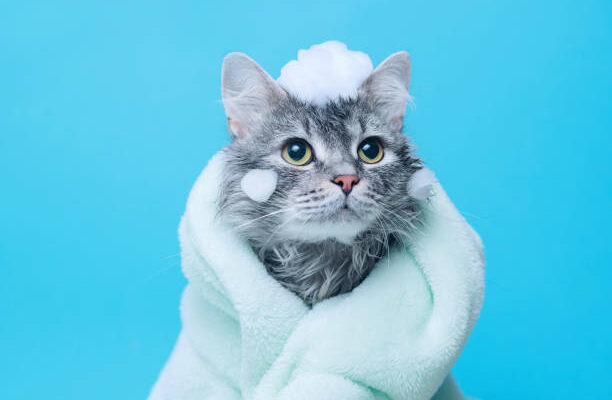Cats are known for being very clean animals. They spend a lot of time grooming themselves by licking their fur. Because of this, many cat owners wonder if cats even need baths and shampoo. The truth is, sometimes cats do need a bath, especially if they get into something sticky, smelly, or harmful. Using the right shampoo is important because a cat’s skin is sensitive, and not all shampoos are safe for them.
In this guide, we will talk about why cats need shampoo, what kind of shampoo to use, how to bathe your cat safely, and some tips to make the process easier for you and your pet.
Why Do Cats Need Shampoo?
Cats are good at self-cleaning, but there are times when shampoo is necessary:
- Fleas or Ticks: If your cat has fleas, a medicated cat shampoo can help remove them.
- Skin Conditions: Some cats have dry or itchy skin that needs special moisturizing shampoo.
- Sticky or Dirty Fur: Sometimes cats get into paint, oil, or dirt that they cannot clean by themselves.
- Show Cats: Cats that participate in shows often need special shampoos to make their coats shine and look perfect.
Remember, not every cat needs regular shampooing like dogs. Most healthy indoor cats only need a bath occasionally.
Why Human Shampoo is Dangerous for Cats
You might think, “Can I use my own shampoo on my cat?” The answer is no. Human shampoos are made for human skin, which has a different pH level than cat skin. Using human shampoo can:
- Dry out your cat’s skin
- Cause irritation or allergies
- Damage their fur
- Make them itchy and uncomfortable
This is why it is always best to use a shampoo made especially for cats.
Types of Cat Shampoos
There are many different types of shampoos for cats. Choosing the right one depends on your cat’s needs:
- Regular Cat Shampoo: These are for normal cleaning and keeping fur soft and shiny.
- Flea & Tick Shampoo: Specially designed to kill fleas and ticks safely without harming your cat.
- Hypoallergenic Shampoo: Great for cats with sensitive skin or allergies.
- Waterless Shampoo (Dry Shampoo): Perfect for cats who hate water. You just spray or apply it and wipe off.
- Medicated Shampoo: For cats with skin infections, dandruff, or irritation. (Always use under vet advice.)
- Deodorizing Shampoo: Removes bad smells if your cat has rolled in something unpleasant.
How to Choose the Right Shampoo
When buying a shampoo for your cat, check these points:
- Safe for Cats: The label should clearly say “for cats.”
- Free of Harsh Chemicals: Avoid shampoos with alcohol, parabens, or strong perfumes.
- Natural Ingredients: Shampoos with aloe vera, oatmeal, or coconut oil are gentle and safe.
- Purpose-Based: If your cat has fleas, get flea shampoo. For allergies, choose hypoallergenic shampoo.
If you are unsure which one is best, ask your veterinarian.
How to Bathe Your Cat (Step by Step)
Many cats do not like water, so bathing them can be tricky. Here is an easy step-by-step process:
- Prepare Everything First:
- Cat shampoo
- A small tub or sink
- Towels
- A cup or spray nozzle for rinsing
- Treats to reward your cat
- Brush Your Cat:
Remove tangles and loose fur before bathing. - Use Lukewarm Water:
Fill the tub with a few inches of lukewarm (not hot) water. - Wet the Fur Gently:
Avoid pouring water on the face. Use a cup to wet the body slowly. - Apply Shampoo:
Use a small amount and massage it gently into the fur. Be careful not to get it in the eyes, ears, or mouth. - Rinse Well:
Make sure no shampoo is left on the fur because it can irritate the skin later. - Dry Your Cat:
Wrap your cat in a soft towel and gently pat dry. Keep them in a warm room until completely dry.
Waterless Bath for Cats
If your cat absolutely hates water, you can use waterless (dry) cat shampoo. This comes as foam or spray.
- Apply the foam/spray on the fur.
- Massage it gently.
- Wipe it off with a towel.
This is a stress-free way to keep your cat clean between regular baths.
Tips to Make Bathing Easier
- Start bathing your cat when they are young so they get used to it.
- Trim their nails before bath day to avoid scratches.
- Stay calm because cats can feel your stress.
- Give treats and praise after bathing to create a positive experience.
- Keep baths short and gentle.
After-Bath Care
After bathing, make sure your cat is completely dry because wet fur can make them cold and uncomfortable. Brush their fur to prevent tangles and keep it smooth. Offer fresh water and let them rest in a warm, quiet place.
When to See a Vet
If your cat has:
- Hair loss
- Red or itchy skin
- Strange smells even after bathing
- Excessive dandruff or wounds
You should take them to a vet before using any medicated shampoo. Sometimes skin issues are signs of health problems that need special treatment.
Conclusion
Shampoo for cats is an important part of pet care but should be used carefully and only when necessary. Always choose a shampoo that is safe and designed for cats, never use human products, and follow proper bathing techniques. With the right shampoo and care, your cat’s fur will stay soft, clean, and healthy without causing them stress.




